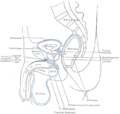| Deep perineal pouch | |
|---|---|
 Coronal section of anterior part of pelvis, through the pubic arch. Seen from in front. (Deep perineal pouch not labeled, but is between the "superior layer" and "inferior layer" labeled at bottom left.) | |
 Vertical section of bladder, penis, and urethra. (Cowper's gland and membranous portion of urethra visible at center bottom.) | |
| Details | |
| Artery | Branches of internal pudendal artery |
| Vein | Branches of internal pudendal veins |
| Nerve | Branches of perineal nerve |
| Identifiers | |
| Latin | saccus profundus perinei or spatium perinei profundum |
| TA98 | A09.5.03.001 |
| TA2 | 2419 |
| FMA | 22061 |
| Anatomical terminology | |
The deep perineal pouch (also Broca pouch or deep perineal space) is the anatomic space enclosed in part by the perineum and located superior to the perineal membrane.


